
10 Free Things to do in Aruba
As I explained in 10 Money-saving Tips for Aruba, this Caribbean island nation is a very expensive place. It’s most affordable for those arriving for luxury vacations, although mid-range travelers and the occassional budget traveler may be able to afford a short trip to Aruba by following various cost-cutting practices.
Meanwhile, Aruba is so expensive that just about everything costs double to triple the prices found in the USA. That includes restaurants & bars, groceries & personal products, rental cars & gasoline and most other things.
On the other hand, Aruba also offers many wonderful activities and attractions that are absolutely free. They include many of the best things to do & see on the island. For visitors on a budget, these activities can be a real ‘life saver’ for enjoying the island.
Following are 10 fantastic activities and sights that anyone can enjoy in Aruba, regardless of their budget.
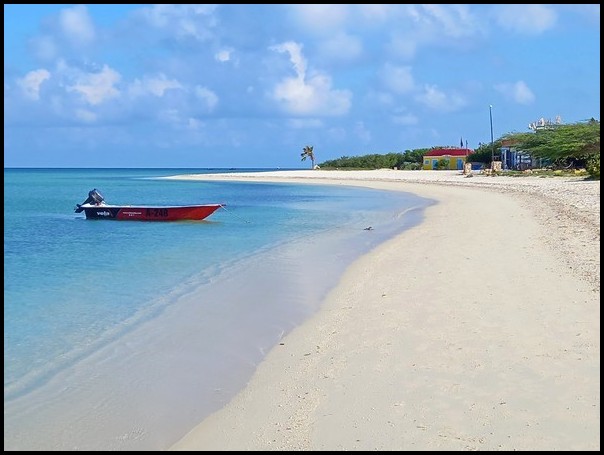
At the beach & sea
1. Beach Activities
Aruba’s main tourist draw is its spectacular, dream-like white sand beaches and clear pale green waters. The island is a beach-lovers’ paradise.
Happily, all the beaches in Aruba are public beaches, open to everyone, free of charge, all the time. So once you hit the beach, you can enjoy suntanning, swimming, relaxing in the sun or shade, hanging out with friends or family, taking a stroll or jog on the sand, and any other beach activities you enjoy.
Just be sure to pack your swimsuit, sunscreen, sarong or beach towel, plenty of water and maybe a nice book to read, and you’ll be set for many days full of free & glorious beach life.
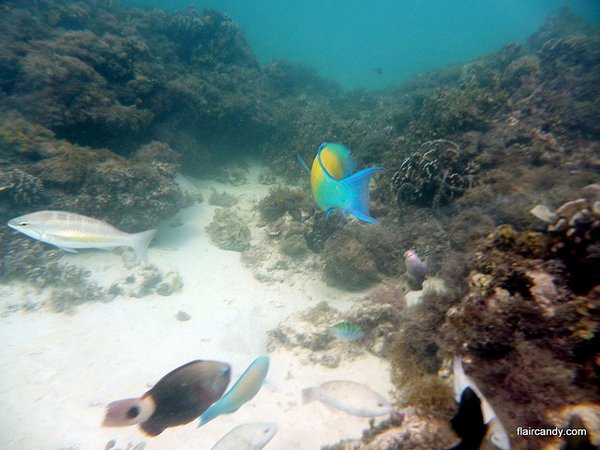
2. Snorkeling
If you have your own snorkeling gear, be sure to take it with you to Aruba. There are several places on the island where you can simply walk in from shore to snorkel over reefs full of tropical fish and marine life.
The most well-known snorkeling spot is in northern Aruba between Arashi Beach and Boca Catalina Beach. You can access the reef between them from either beach.
Truth be told, the corals are actually in pretty bad condition, but the fish life is fantastic. And there are plenty of sponges as well as a few healhty corals, soft corals and anemones.
The only cost involved in snorkeling (if you have your own gear) is getting to/from the walk-in spots. Having a car is the best option, but regular public buses run between Arashi Beach and Orajestad. As long as you’re close to the bus route, it’s easy to get there, even if you don’t have a rental car.

3. Walking
No matter where you are in the world, walking is always free. And in Aruba there are many, many places to walk & hike.
For starters, the whole west coast of Aruba is lined by a series of long, beautiful beaches. Nearly all hotels and other accomodatoins are also located near the west coast. So no matter where you are staying, you can walk along the beaches and western coast of the island.
In the northern Palm Beach area, a series of continuous 7-mile / 11 km sidewalks run between the neighboring hotel grounds and their beaches. The walk passes through hotel gardens and past many restaurants, cafes and bars.
Running north from Ritz-CArlton, the northernmost resort, there’s a 3 km sidewalk that hugs the coast all the way up to Arashi Beach. There are no resorts in this section. The walkway passes along beautiful rocky shores and beaches, with great open views over the sea. Note though, that it also runs right beside the coastal road.
Many other, much more remote walking trails and dirt roads are located all over the island, from the northernmost tip all the way down to the southern tip.
Some major areas include the vast, open region north of California Lighthouse on Aruba’s northern shores; the Alto Vista Trail, which starts & ends at remote Alto Vista Chapel near the east coast; trails in Arikok National Park; Hooiberg Hill; and the cliffs at Aruba’s southern end (see more on these below).
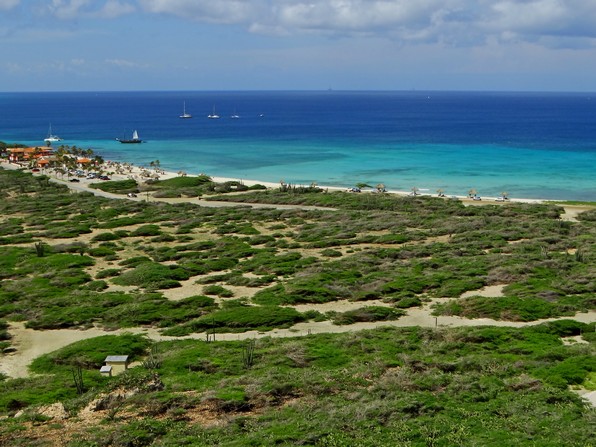
Around the island
Although Aruba is most famous for its glorious beaches, the island also has a surprisingly diverse natural landscape, with many interesting and beauful natural features.
There are rock formations, cliffs, caves, natural sea pools, sand dunes, lagoons, salt flats, cactus scrub, savannahs and more. All of them are free to visit, though you will need transportation to reach them.
* Note that one of Aruba’s most famous natural places is Arikok National Park. I have not included it in this article because it has an admission fee of $11 US, as of 2021. There are a couple natural features in Aruba that you can only access inside the park, but most of Aruba’s stunning natural features you can experience elsewhere, without needing to enter the park.
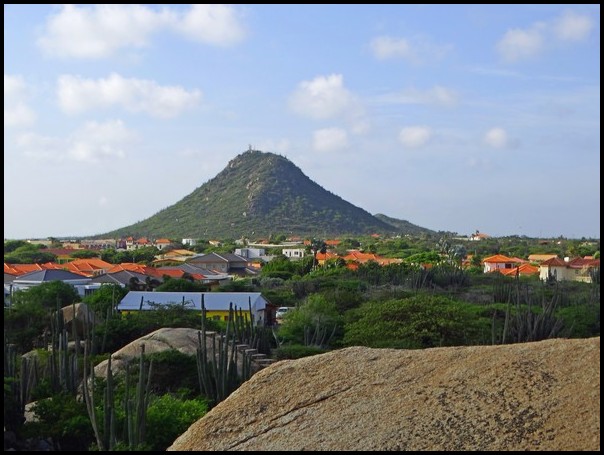
4. Hooiberg Hill
The nearly-perfect conical form of Hooiberg Hill, near Oranjestad, is instantly recognizable from many points on the island. Hooiberg is Aruba’s highest hill at ft / M (and one of the island’s only hills) and, not surprisingly, is of volcanic origin.
A fun, albeit strenuous, activity in Aruba is climbing up Hooiberg’s very steep stairs past tall cactii & thorn bushes to the top. It’s only a 10-15 minute hike up, but you’ll be huffing and puffing by the time you reach the top.
Once on top, you can catch glimpses of the island and the Caribbean Sea in various directions through the rather dense tree and bush foliage. Enjoy the shy wandering hill goats, there looking for food handouts, before heading back downhill.
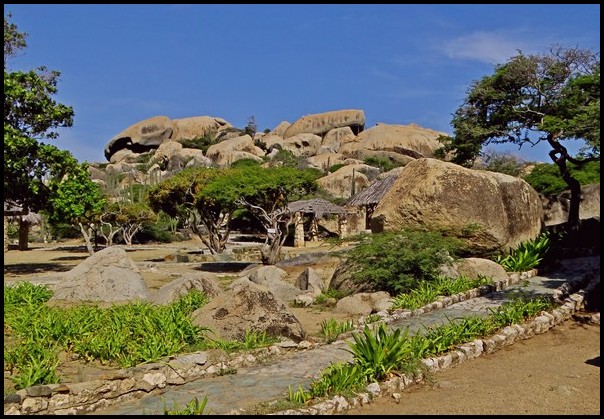
5. Ayo Rock and Casibari Rock Formations
Just northeast of Hooiberg Hill are two separate rock formation regions, each set in a spacious walled park with walkways. Both areas consist of huge house-size and car-size boulders strewn about large cactus fields.
Ayo Rocks are the largest and most famous region. An interesting walkway leads between massive boulders and through naturally-formed ‘tunnels’ where rocks lean into each other. Various dirt side tracks weave upward through more boulders.
Ayo is actually most famous for its ancient petroglyphs- paintings inside small caves made by the Caquieto Indians who originally settled Aruba as early at the 2000s BC. Viewing the petroglyphs is also free to the public and the main walking path leads right past them.
Casibari Rocks are a smaller collection of giant boulders, located a 10-minute drive west of Ayo Rocks. Casibari is also worth visiting, especially since the walking route leads onto the very top of the boulders, where fantastic views of Hooiberg Hill can be enjoyed.
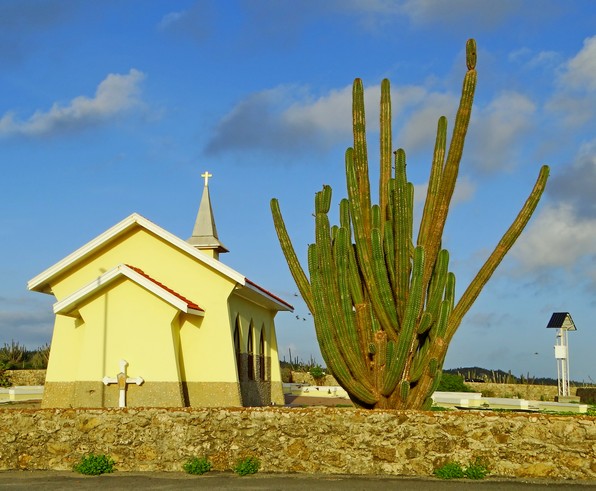
6. Alto Vista Chapel & region
Alto Vista Chapel has the claim of being the first church built on Aruba. It’s located in northeastern Aruba, more or less directly east of Palm Beach and close tothe far east coast.
The small golden chapel is utterly adorable and also provides sweeping views over the remote east coast. Although the original chapel is no longer there, this newer church was built in the same location and is an important cultural & historical icon for many local Arubians.
The long looping Alto Vista hiking/cycling trail starts & ends at the chapel, for those who want to explore further on foot or wheels. Dirt roads lead down to the east coast and its wild, wind-swept beaches.

7. Bird & Animal spotting
While you’re out enjoying Aruba’s stunning beaches and exploring the island, keep your eyes open for Aruba’s abundant pretty birds and lizards. There are also wandering donkeys and herds of wild goats, descendent from animals imported by the Spanish in the 1500s.
Commonly sighted birds include the beautiful bright yellow & black Tupials (an Oriale) and smaller Bananquits, Carib Mockingbirds, Carib Grackles, various pidgeons, small doves, Crested Caracaras (a falcon), seagulls, herons, egrets, pelicans and several other marine birds.
Lizards include tiny bright lime-green iguanas, small electric blue Whiptail Lizards and larger brown/green iguanas.
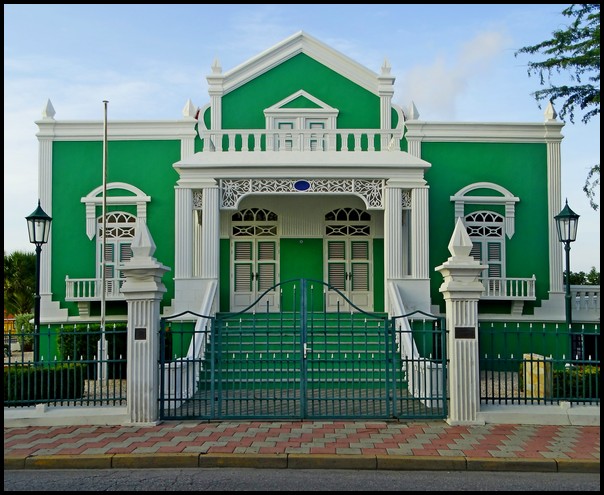
In Oranjestad
8. Self-guided walking tour of historic Oranjestad
Aruba is one of many Caribbean islands that was colonized by the Dutch. Holland held sway over Aruba for 350 years, from 1636-1986, when Aruba finally became an independent country. I wrote in depth about Aruba’s history in my article on the ABC Islands here.
The capital, Oranjestad, was developed by the Dutch in the 1800s. Today more than a dozen beautiful historic Dutch buildings still stand, scattered about downtown. They include the bright green Town Hall building,Fort Zoutman Tower & history museum, San Fransisco de Asis Cathedral, the Old Protestant Church, buildings comprising the Archeaological Museum, several government buildings and several small houses, now converted into shops and restaurants.
You can easily make a self-guided historic walking tour of these gorgeous buildings by following Google maps or a paper map of Oranjestad. Many buildings have informational plaques out front, explaining their histories.
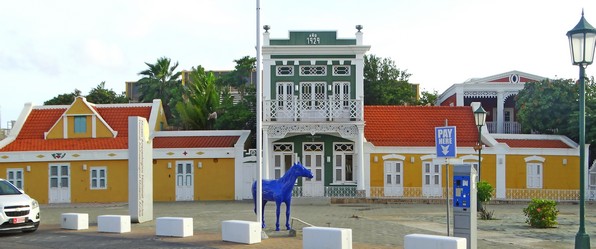
9. Archaeological Museum
Aruba’s small but very informative Archaeological Museum is housed in a collection of adjacent former mansions. Amazingly, the museum is completely free.
The museum focuses on the ancient history of Aruba and the Coquieto & Arawak Indians who orginally settled the island, starting as early as 2000 BC. They migrated from nearby South America, particularly from Venezuela.
This is one of the few places where you can learn about this aspect of Aruba’s past and culture.

10. Renaissance Hotel lobby
Renaissance Hotel sits smack in the middle of downtown Oranjestad, right in front of the marina and cruiseship port.
Just in front of the hotel entrance, the main road humps up over a small bridge that crosses a narrow canal at the back of the marina.
It turns out that this canal leads under the road and directly into the middle of the hotel’s lobby!
At the bottom floor of the hotel’s soaring, multi-level lobby, there’s a cordoned-off waiting area beside the waterway. Hotel guests wait for the next incoming shuttle boat to take them out to the hotel’s private island, where only Renaissance guests can lounge on beach chairs, dine, drink and watch a flock of bright pink flamingoes strut by.
If you’re not staying at Renaissance, you can’t visit the island. But you can certainly go check out the hotel’s very unusual lobby, with its private canal and boat pick-up/drop offs.
While you’re there, head up to the lobby’s upper level and go out to the pool deck. There you’ll have fabulous views over the marina and any cruiseships that might be in port that day.
=============================
You might also enjoy:
10 Money-Saving Tips for Aruba
All About the Caribbean ABC Islands
==========================


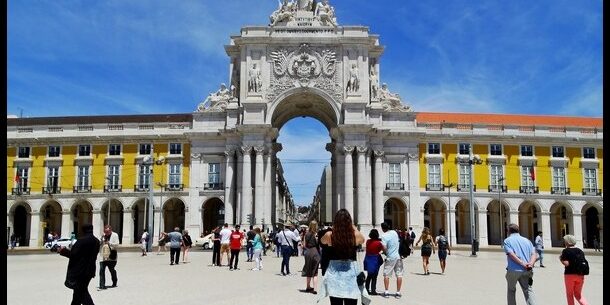


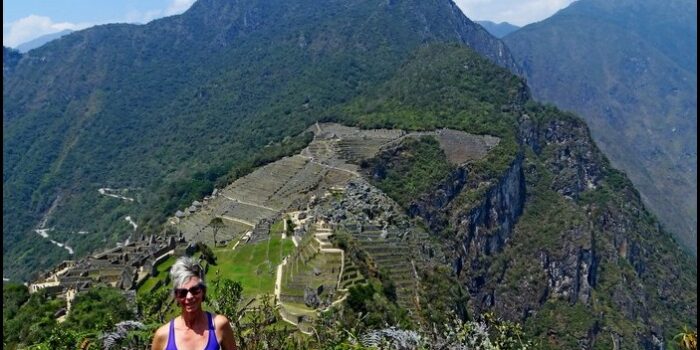
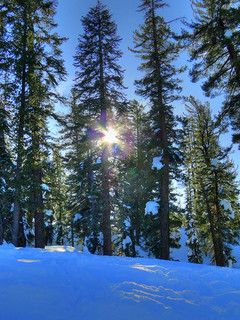

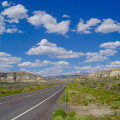


 Hi! I'm Lash, an American nomadic world traveler who's been traveling solo since 1998. I’m passionate about traveling the world nomadically and then sharing it all with you. I hope to inspire you to travel the world, to entertain you with tales from the road, and to help you reach your travel dreams. Welcome!
Hi! I'm Lash, an American nomadic world traveler who's been traveling solo since 1998. I’m passionate about traveling the world nomadically and then sharing it all with you. I hope to inspire you to travel the world, to entertain you with tales from the road, and to help you reach your travel dreams. Welcome! 



